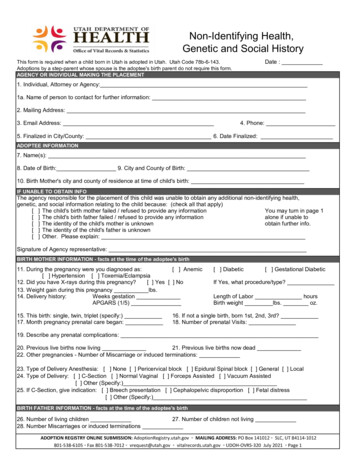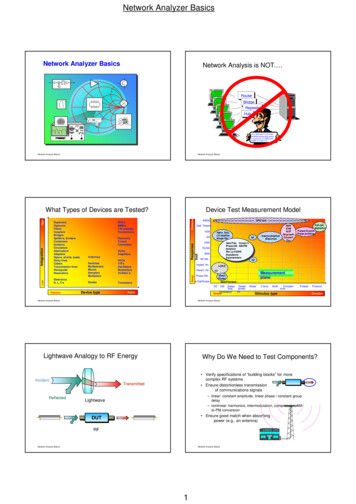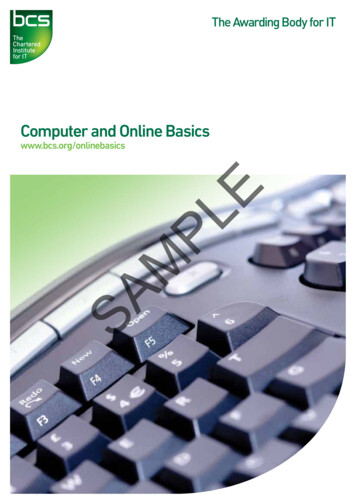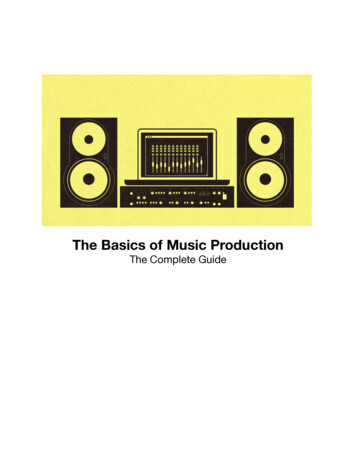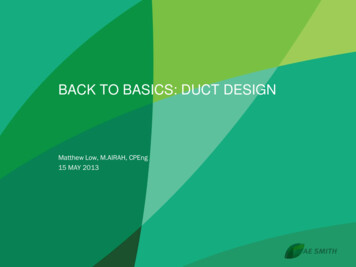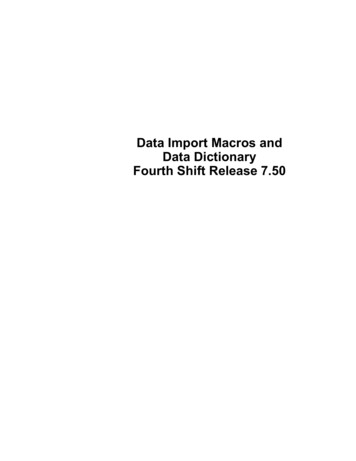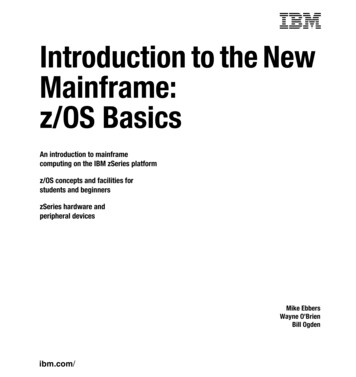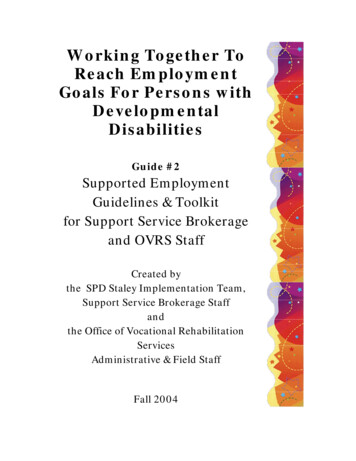
Transcription
Working Together ToReach EmploymentGoals For Persons withDevelopmentalDisabilitiesGuide #2Supported EmploymentGuidelines & Toolkitfor Support Service Brokerageand OVRS StaffCreated bythe SPD Staley Implementation Team,Support Service Brokerage Staffandthe Office of Vocational RehabilitationServicesAdministrative & Field StaffFall 2004
TABLE OF CONTENTSIntroduction4Supported Employment Services Flowchart7Stage 1Employment ScreeningTools1A Essential SE Worker Characteristics List1B OVRS Eligibility Determination Checklist81011Stage 2VR Application MeetingTools2A Social Security Work Incentives Screening2B Consideration of a PASS Plan as a Resource2C Oregon & National Benefits Planning Resources13Stage 3Establishing Vocational GoalsTools3A Guidelines for Employment Person Centered Plans3B Content of Employment Person Centered Plan3C Guidelines for Use of Community Assessment3D Sample Questions for EPCP & CommunityBased Assessments19Stage 4Supported Employment Plan ImplementationTools4A Supported Employment Plan Checklist4B Brokerage Goal Survey Sheet Template4C VR Individual Plan for Employment Template4D Brokerage Supported Employment ISP Template2141617202325283031323541
Stage 5Vendor SelectionTools5A OVRS Vendor Expectations/Code of Conduct5B Brokerage Provider Qualifications Checklist5C Customer Suggested Vendor Interview Questions5D SPD Policy on Use of Coworkers in SupportedEmployment5D Business/Coworker Certification for ProvidingSupported Employment424344454850Stage 6Delivering & Monitoring Short-term ServicesTools6A Vendor Report Template6B Work Site Analysis Review Components52Stage 7VR Case ClosureTools7A VR Closure Report Template56Stage 8Brokerage Ongoing Employment SupportTools8A Elements for Brokerage Quarterly Reviews6061AppendicesVR-DD Workgroup Membership ListSPD Support Services Rate Range Memo and TableSample Integrated Plan, Vendor Report & VR Closure6365733535457
IntroductionA Mandate for PartnershipBeginning in 2002, new support services and funds became availablethrough the Staley Settlement to help individuals with developmentaldisabilities maintain independence at home and in their communities.The Staley Settlement represented a renewed opportunity tostrengthen the partnership that brings together time-limited servicesprovided through the Office of Vocational Rehabilitation Services(OVRS) and long-term support available through Seniors and Peoplewith Disabilities (SPD) and DD local resources to help individuals withdevelopmental disabilities get and keep a job through supportedemployment. Although there had been success in interagency orjoint efforts between local Support Service Brokerage PersonalAgents and VR Counselors, the service system lacked a clear modelof how to service providers would best work together.An Interagency Workgroup was established in late 2003. Members ofthe workgroup included Brokerage Directors, Personal Agents, VRCounselors, VR Branch Managers, family members of people withdevelopmental disabilities, advocates for people with developmentaldisabilities as well as representatives from both DHS’ StaleyImplementation Team and OVRS’ Administration Unit. Theirmandate was to: Identify the process that would support effective servicesand real employment outcomes for customers; Develop and or identify tools that would increase staff andcustomer understanding and participation in the process.This diverse membership brought varying levels of understanding ofthe service systems involved and varying experiences related to thesuccess of collaboration between systems. Through honestcommunication and personal commitment, the workgroup membersdiscovered that they were united in their belief that employment hasgreat value, builds self-esteem, encourages self-empowerment andenriches the life of the worker as well as the lives of those closest tohim or her.4
The Products of the WorkgroupThe VR/DD Workgroup is proud to share with you the followingmaterials designed to increase understanding and success for allinvolved in a partnership to achieve competitive employment.Guide #1 The BasicsIdentifies the common values, process, general guidelines andoutcomes that are the foundation of the VR/DD partnership toachieve supported employment for common customers.Guide #2 The ToolkitIdentifies interagency guidelines and best practice tools foreach major stage in the service delivery process.Guide #3 Customers’ GuideInformation provided in a user friendly manner to help personswith developmental disabilities and their families understandand make informed choices in the process of getting andkeeping a job and career.A Note on TerminologyThroughout these guides, individuals with developmental disabilitieswill be referred to as “customers.” The authors acknowledge thatservice providers outside the brokerage system use other terms,including client, consumer and participant. Since the term “customer”better reflects an individual’s right to choose to participate and toengage as a full partner in the process, that term has been selectedfor use.The term “DD Personnel” is used in situations where the policyrelates to Brokerage Personal Agents assisting customers withdistinct person centered support service plans and budgets and/orCounty DD Services Coordinators assisting customers with an ISPthat may include a slot payment to a designated provider foremployment or other services.5
How to Use this ManualThis manual includes both guidelines and tools for use by OVRSCounselors, Brokerage staff and DD Case Managers as they worktogether to provide supported employment services to their sharedcustomers. The guidelines are separated into sections, which matchthose found in the Joint Services Flowchart. Examples of the toolsreferenced in the guidelines may be found immediately following eachsection; electronic and printed copies will be made available throughOVRS Administration and SPD Staley Implementation Team. Toolsshould not be revised, altered or otherwise changed withoutauthorization from SPD Staley Implementation Team and OVRSAdministration.6
Supported Employment Services FlowchartStage 1Employment ScreeningStage 2VR ApplicationStage 3Establishing Vocational GoalsStage 4Planning & Implementing Funding(VR IPE & Brokerage ISP)Stage 5Vendor SelectionStage 6Delivering & Monitoring Short-termSupported Employment ServicesStage 7VR Case ClosureStage 8Providing Ongoing Supports7
Stage 1: Employment ScreeningPersonal Agent uses Person Centered Plan, VR Eligibility Checklist and otherinformation to identify potential joint service customers.Guidelines:1. Brokerages use a General Person Centered Plan to look at fulllife needs and desires of customers. This tool initially identifiesa person’s interest in competitive supported employment.2. DD Brokerages and County DD programs will refer to VRpersons with developmental disabilities who:a. Have a disability (based on diagnosis or on SSI/SSDI)b. Desire a job in an integrated setting earning a competitivewageI. An integrated setting is one where workers withdisabilities and workers without disabilities are employedand interact together.II. Job Coaches and others providing employment supportsare not included in the definition of “workers withoutdisabilities” for this definition.III. Enclaves cannot be defined as integrated settings.c. Are in need of time limited resources to get & learn a jobd. Can demonstrate, with assistance if needed, that there is areasonable expectation that identified natural (unpaid) andpaid resources are adequate to help the individual keep ajob.3. Under the Rehabilitation Act of 1973 (as amended), persons onSSI or SSDI are presumed eligible for vocational rehabilitationservices and capable of engaging in gainful employment.OVRS or the Commission for the Blind must therefore providethem the opportunity to explore gainful employment inintegrated settings.4. If agreed to at the local VR Office level, Brokerage staff willprovide an initial orientation to potential customers to increaseunderstanding, collaboration and effectiveness in the referraland application process.8
5. DD personnel will work with the customer and family to gatherall available information to assist in confirming eligibility andplan development. This will be reviewed at the VR applicationmeeting.Tools:1A Essential Supported Employment Worker Characteristics1B OVRS Eligibility Determination Checklist9
Tool 1AOVRS Essential Supported EmploymentWorker CharacteristicsEssential To Open VR Case I want to work I have a positive attitude about working in some field I have a Social Security card and an ID card I am in good health My place of residence is stable and I can focus energy onworking I can ask for help when needed I have shown an ability to be dependable, to work withothers, and accept direction in some environment My Team feels that there is a reasonable expectation thatthe level of long term support to help me keep my job can bedeveloped through one or more sourcesEssential to Write VR Plan I have specific job goals I have been dependable and on time in terms of work withVR counselor and other activities I enjoyEssential at VR Case Closure I understand job expectations The accuracy and quality of my work is good I have good attendance I can accept a supervisor telling me what to do The long term supports to help me keep my job have beenidentified and are in placeDesirable But Not Required I have good hygiene I have proper clothes for interviewing I have good references I have a good resume I have good interviewing skills10
Tool 1BOffice of Vocational Rehabilitation ServicesEligibility Determination ChecklistWhat Kind Of Information Can Be Used To Determine Eligibility? Medical/ Psychological Reports From County Records School Reports and IEPs Adult Vocational Agency Reports or Case Notes Reports From Family and Professionals who know thecustomer Customer Self ReportingList and Document Specific Impairments and Diagnoses (list all)List all Specific Needs and Accommodations Required to Getand Keep Employment (hours worked per week, work schedule,work site, job carving, job coaching, ongoing employment supportneeds, transportation etc. If unknown, indicate so.)11
Review and Identify Functional Loss or Needs for Support inSeven Areas (Check and document all that apply. The Team will then work toidentify strategies to provide supports or otherwise address the issue.)1. Communication Barriers Does not readily understand others Not readily understood by others Requires aides for conversation Uses single words or short phrases Speech is rambling or illogical Talks and interrupts excessively Unable to converse via telephone2. Interpersonal Barriers Conflict with coworkers Isolation or withdrawal from coworkers Inappropriate response to others Negative work history Unacceptable interactions at work3. Mobility BarriersUnable to use public transportationNeeds ongoing assistance in community4. Self-Care Barriers Needs monitoring to prevent injury Poor decision making Requires assistance personal needs Requires assistance handling money5. Self-Direction Barriers Requires constant supervision Requires frequent supervision Short attention span on desirable activity Unaware of consequences of behavior6. 7. Work Skill BarriersReading, spelling and/or math skills below 5th gradeDifficulty learning new skillsLimited task sequence recallRequires accommodation or rehabilitation technologySignificantly reduced speedWork Tolerance BarriersCannot lift more than 20 lbsMisses 3 or more days a monthMust pause to climb stairs12
Stage 2: VR Application MeetingThe initial meeting between customer, family, PA and counselor (the Team) toreview supported employment process, timelines and resources. This meeting isexpected to end with a VR file being opened.Guidelines:1. As soon as possible following initial contact, OVRS willschedule an application meeting for each DD consumer,advocate or family members, and Personal Agent to discussessential planning components. If the individual desires topursue employment at the end of the meeting, VR will open afile.2. From the initial meeting and throughout the process, the teamis responsible to review basic plan components includinginterests, skills, barriers, short term and long term needs andstrategies in supported employment, benefits counseling,benchmarks for progress toward employment and jobstabilization.3. As part of the review of available resources, it is theresponsibility of the VR counselor and PA to:a. Complete the Social Security Work Incentives ScreeningTool. Information gathered can used by the team (withthe assistance of a Benefits Planner) to identify both theimpact paid employment may have on existing benefitsand the availability of Social Security Work Incentiveresources to help achieve the employment goal.b. Determine if further assistance is needed from a RegionalBenefits Specialist and engage then to join in the teamc. Discuss how all team members will be engaged in thewriting of a Plan to Achieve Self Support (PASS) ifappropriate in order to ensure consistent and effectiveservice and use of all resources.Tools:2A Social Security Work Incentives Screening Tool2B Considering a PASS Plan as an Employment Resource2C Oregon and National Benefits Planning Resources13
Tool 2ASocial Security Work Incentive AssessmentNameAddressPhoneSocial Security #Blind: Yes No1. Identification of Employment Goal and Service NeedsAre you interested in starting a community job or expandingcurrent job?What is your work goal?What would you need to reach this goal? (job development, training,support, transportation etc)2. Employment TeamAre you an OVRS/OCB client? Yes NoVR Counselor’s Name:Are you a Brokerage Customer? Yes NoPersonal Agent’s Name:DD Case Manager (if any)Provider/ 14
3. Review of Resources Available and NeedsAre you currently . . .Receiving SSI?Receiving SSDI?Other Unearned IncomeWorkingMarriedRaising AmountWagesSpouse wage/benefitsChild BenefitDo you have . . .A Rep PayeeOver or under payment(Non trust) Resourcesgreater than 2000Resources greater than 12,000Yes NoYes NoPayee’s Name:How much?Yes NoWhat?YesWhat?NoIf you are currently working . . .What is your job?When did you start working?What are your current hours and wages?Have you done other jobs in the past 2 years?Are you paying for impairment related expenses?Current monthly expenses . . .What are your approximate living expenses What other monthly expenses do you have? 15
Tool 2BConsidering a Plan To Achieve Self SupportAs a Resource For Employment PlanningStep 1: Employment Team (OVRS Counselor & Personal Agent) willcomplete Social Security Work Incentive Assessment FormThis is a form designed to gather essential information relevantto use with any of 13 work incentive programs.Step 2: Answer “ Yes” to the following questions based upon theinformation available to consider PASS; if PASS is not an option,pursue other work incentives as available.1. Person can identify a community employment goal to earnmore than 830/mo ( 1350 if blind) in next 2 years?2. Person is in need of some service and support to achieveemployment goal?3. Person has funds other than SSI to use towardsemployment goal (wages, SSDI, other)?4. Person on SSDI who becomes SSI eligible understandsand can live on monthly funds available?5. Person has less than 2000 in unprotected resources tomaintain SSI eligibility?Step 3: Identify a ballpark figure for funds available through PASS plan:1. Unearned SSDI FormulaSSDI check - 20 amount in PASS Plan monthly 604/mo - 20 584/mo PASS plan and 7008 year toachieve employment goal (for 6 month-3 year period,based on plan)Person begins receiving SSI check for living expenses Medicaid- Medical Card for medications etc Medicaid benefit level at Brokerage2. Earned Income Wages Formula(Monthly wages - 85) /2 Amount in PASS Plan monthly 600- 85/2 257.50 PASS/mo and 3090 PASS/year16
Tool 2COregon and National Benefits Planning& PASS ResourcesMost named resources will assist with benefits (financial planning) while the EmploymentTeam will write and monitor the PASSOregon ResourcesPASS Plans submitted to:PASS Cadre Region XSocial Security AdministrationSeattle Regional OfficeSuite 2900 M/S 33C701 Fifth AvenueSeattle Washington 98104-7075Tino Flonesca or Vera Brodsky(206) 615 2627 or 1-888-674-6251Benefits PlannersOregon Advocacy CenterMolly Sullivan, Doug Zeh and Kathy Colemanmsullivan@oradvcacy.org503 243-2081Hotline Wed. 2-5 answer questions for those registered: 1-800-452-1694John Newman (working on capacity building more than individual assistance)SPD Benefits SpecialistJohn.newman@state.or.us(503) 945- 6453CORIL Central Oregon Resources For Independent LivingBend (541) 338-8103Contact Glen Van CiseHASL Independent Abilities Center2 Ben. PlannersGrants Pass (541) 479-4275Contact Tina SayreILR Independent Living Resources1 Ben. PlannerPortland (503) 232-7411Contact Sue WestwoodSPOKES Unlimited1 Ben. PlannerKlamath Falls (541) 883-7547Contact Tami MartinUVDN Umpqua Valley Disabilities Network1 Ben. PlannerRoseburg (541) 672-6336Contact Scott Cohan2 Ben. PlannersOtherJanet Steveley/ Workable Solutions (provides training and TA)janet@ashlsndhome.net(541) 488-649517
National ResourcesSocial Security and Work IncentivesSocial Security Administration Home Pagewww.ssa.govSocial Security Red Book on Work k.htmlInformation and Example PASS Planswww.passplan.orgOnline assistance to help monitor work incentiveswww.ssimanager.comTechnical assistance, chat rooms and resource materialswww.griffinhammis.comInformation on Benefits Planning Assistance and Outreachwww.vcu-barc.orgWork Incentives and Supported EmploymentVirginia Commonwealth Universityhttp://www.worksupport.comCornell Universityhttp://www.ilr.cornell.edu/pedUniversity of Montana Rural s plan.htmlInstitute For Community Inclusionhttp://www.childrenshospital.org/ici18
Stage 3: Establishing Vocational GoalsThe team will identify present interests/goals; if needed they will arrange anEmployment PCP or additional assessment activities to identify career choices.Guidelines:1. If additional information is needed to establish an effective goalor plan OVRS counselors and the Team will consider gatheringinformation using:a. Employment Person Centered Planb. Community Based Work Evaluationc. Facility Based Assessment.2. Community or Facility Based Assessments will be used onlywhen the Employment Person Centered Plan does not succeedin providing all essential information.3. OVRS and DD personnel are active participants in theEmployment Person Centered Planning process.4. In most cases, the PA is responsible for coordinating andfacilitating the Employment PCP. In cases identified by theteam as especially challenging, OVRS may pay for a facilitator.Tools3A Guidelines for Employment Focused Person Centered Plan3B Content of Employment Focused Person Centered Plan3C Guidelines for Use of Community-based Assessment3D Sample Questions for Use with PCP or Community-basedAssessment19
Tool 3AGuidelines for Employment FocusedPerson Centered PlansFollowing the customer’s initial meeting with VR and the Brokerage,the team may initiate a person-centered planning process to preparefor the VR Employment Plan. The process gathers pertinentinformation and lays the foundation for the customer’s success.Following is a description of the process and what is recommendedfrom that process.The Person Centered Planning Process:Participants: The process will include a formal Person CenteredPlanning meeting(s) led by a trained facilitator. Participants includethe customer, guardian, significant family and friends, the BrokeragePersonal Agent, and the VR Counselor. Community members suchas potential employers, job developers/job coaches, or others whohave a contribution may also be invited. All invitations are made atthe discretion of the customer.Facilitating the Process: the Personal Agent, with the activeinvolvement of the customer, oversees The Person CenteredPlanning process. The process is coordinated with the VR counselorand other participants. Generally, the Personal Agent will facilitatethe PCP meeting however in certain circumstances, it may be wise toemploy the expertise of the Job Developer or a consultant whospecializes in Employment focused Person Centered Plans.Facilitator Role: It is expected that the facilitator will talk with thecustomer in advance to ensure that he/she understands the purposeof the meeting and his/her role in the process. It is also expected thatthe facilitator will accommodate the customer’s communication style.For example, graphic facilitation may be necessary for a customerwho has limited reading skills or a meeting may need to be sloweddown for a customer using an augmentative communication device.The Meeting: The Employment Focused Person-Centered Planningmeeting is held at a place chosen by the customer and at a time that20
is convenient for the customer and his/her significant others.Meetings are generally scheduled for about 2 hours. During themeeting, it is expected that full attention is given to the process andcell phone calls or other distractions are limited.When the PCP recommends gathering additional information: Theprocess may also include a person-centered Vocational ProfileAssessment. The Vocational Profile Assessment is based uponobservations of the customer in his/her natural community (i.e.volunteer job, school setting, or community activities). This detailsspecific tasks, learning style, and elements of a work culture thatwould be important for the customer’s success on the job. AVocational Profile Assessment should generally require no more than20 hours to complete.Documentation: Information gathered from all Person CenteredPlanning activities is summarized in a formal document with copiesfor the customer, Brokerage, and OVRS.Recommended Components for the Employment FocusedPerson Centered Plan*:Meeting Record: Record the date and who is participating in themeeting(s). This is very important as information and is updated ifparticipants in the process change.History: Capture information about the customer’s experiences thatcontribute to employment skills. Record the personal historyincluding previous paid and volunteer jobs, school, chores,participation on projects, being on a team, hobbies etc.Strengths: Describe the customer’s strengths, gifts, capacities, andabilities. These must be in sufficient detail that a job developer couldvisualize the types of jobs that may be possible.What Works and Doesn’t Work: Describe “What Works?” and “WhatDoesn’t Work?” Gather specific information on items that will impactthe customer’s success on the job. (i.e., learning style,21
communication methods, safety issues, environment/work culture,social interaction preferences).Challenges and Support Strategies: Describe the challengesassociated with developing and maintaining a job for this customer.Describe support strategies to address each of these challenges orensure that they are noted in the Action Plan. Typical challenges thatmay emerge include lack of transportation, funding for long-termsupports, finding skilled providers and reliance on others for PersonalAssistance needs. This will address barriers identified on the OVRSEligibility Determination Checklist (Tool 1B).Resources: Complete a comprehensive review of the public andprivate (including local) resources that the customer can access fordeveloping and maintaining a job. Assure that the customer has theinformation necessary to make informed choices regarding his/heremployment and resources. This information will relate to SSWIscreening and Benefits Planning (Tools 2B, 2C & 2D).Ideal Aspects for a Job: Based upon information garnered in theplanning meeting, brainstorm aspects to create or carve a job for thiscustomer. This includes types of tasks, environment/work culture,geography, social interactions, health and safety issues etc.Brainstorm where in this customer’s community one would find thisemployer. (The more specific the better!)Community Connections: Identify community connections, withspecific names and contact information that can assist with theemployment process.Action Plan: Lay out an Action Plan that describes the “Next Step”activities with responsible parties and timelines. This would includethe development of the VR Employment Plan.*Information from the PCP can be used later to develop theIndividualized Plan for Employment (IEP), Individualized Long-termSupport Plan (ISP), vendor expectations and the customer’s resume.22
Tool 3BContent of an Employment FocusedPerson Centered PlanStrengths, Interests, and AbilitiesWhat do you like to do?What are your interests?What are the things that you do well?What so others compliment you on?Past jobs or tasks that you enjoyed doing?Skills and interests you have shown at home?What Works For You?What do you like about working?What keeps you interested (money, friends, environment)?What keeps you in a good mood?What can bring you out of a bad mood?Specific jobs or tasksWorksite preferences (time, temp, noise, clothing)Expectations of a job (pace, detail level, quality)What Doesn’t Work?What things make it harder to do a job?What do you dislike?What do you do when you really dislike something? (Get adescription of behavior)Work HistoryJobs, volunteer experiences, school experiences including job titles,dates, what helped in success.What kinds of things do you so at home to help out?What classes have you taken?Possible Support NeedsConsidering mobility, transportation, self-care, work skills, socialskills, time awareness and specific training needs:What help would you need to get a job?What help would you need to learn a job?What help would you need to keep a job?What would make your job easier?23
Ideal Situation/ Possible JobsWhat would the ideal job look like?What things are really important and should be part of your job?Where to Look? Who Do We Know?Brainstorm specific businesses in the community with jobs or worktasks that match the idealThink of people you know that work in those businessesThink of people who might have information about your ideal jobPossible ResourcesWhat family member or friend might help?Who else in the community may help?Which agencies will help?Complete benefits and resource analysisNext StepsWhat do weneed to do tomake thishappen?Who will doeach step?When will theydo it?Persons Contributing:24How do we know itsbeen done?
Tool 3CGuidelines for Use of Community-Based AssessmentIntent of Assessment To help clarify information requested by VR to documenteligibility and or assist in plan development To help OVRS and DD partners provide timely service byagreeing upon the information needed and method for itscollection. To help OVRS and DD partners identify the point of jobstabilization and transfer from time limited (VR) to long term(DD) funding To clarify vendor expectations in assessment, job developmentand or job trainingConsiderations in Assessment ProcessAssessments can be delivered in many formats and jointly usedby the team.The overall “Assessment” is a process of gathering information andallowing multiple interpretations so that we may learn and developrecommendations for services and supports leading to successfulemployment. The information may be drawn the sources as listedbelow. Initial Person Centered Plan: This overall quality of life planwill lay out dreams and aspirations that will guide the directionof assessment and future rehabilitation activities. It is throughthis process that the individual identifies community based(supported) employment at minimum wage as a personal goal. Information From Family, Professionals and AvailableWritten Reports: At the time of an application meeting, thefamily and others can provide essential information aboutpresent functioning level, interests and abilities, and successfulstrategies for working with the individual. Medical, school, workhistory, other reports may also address specific eligibility criteriaand areas of functional loss required by VR.25
Employment Focused Person Centered Plan: Completedwith VR counselor and the team, if needed to open case or togather additional information during vocational exploration. Formal Assessment: Not a required step, but rather oneinitiated only if information from all other sources is notadequate to address eligibility and plan content. Any formalassessment paid for with VR funds should clarify specificquestions or provide essential information needed to proceedwith the development of a Individual Employment Plan definingshort term (VR) and Long term (DD).o Community Based Assessment should be done for adesignated period in environments similar to the identifiedinterests of the customer.o Facility Based Assessment is not recommended for DDcustomers considering supported employment becausestandardized assessments are not good predictors ofsuccess in another future work setting.The primary purpose of assessment data is for use in thecompatibility matching process.Matching is the process where significant factors are comparedbetween an individual and an employment situation. What we wantto do is match a person to a job and determine the odds for successgiven currently available supports. Team members should alsoconsider what additional supports may be needed in both the shortand long term.Assessments provide information for the customer to use tosupport choice.Information comes from more than one source, provides more thanone recommendation, and looks at potential job fields. Assessmentsdo not pro
discovered that they were united in their belief that employment has great value, builds self-esteem, encourages self-empowerment and enriches the life of the worker as well as the lives of those closest to him or her. 5 The Products of the Workgroup The VR/DD Workgroup is proud to share with you the following materials designed to increase understanding and success for all involved in a .
